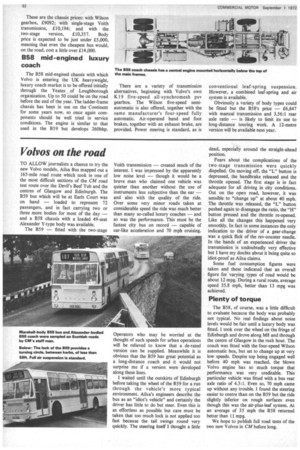Volvos on the road
Page 34

If you've noticed an error in this article please click here to report it so we can fix it.
TO ALLOW journalists a chance to try the new Volvo models, Ailsa Bus mapped out a 165-mile road route which took in one of the most difficult sections of the CM road test route over the Devil's Beef Tub and the centres of Glasgow and Edinburgh. The B59 bus which will be at Earls Court was on hand — loaded to represent 72 passengers, and in fact carrying two or three more bodies for most of the day — and a B58 chassis with a loaded 49-seat Alexander Y-type body was available.
The B59 — fitted with the two-stage Voith transmission — created much of the interest. I was impressed by the apparently low noise level — though it would be a brave man who claimed one vehicle was quieter than another without the use of instruments less subjective than the ear — and also with the quality of the ride. Over some very minor roads taken at considerable speed the ride was much better than many so-called luxury coaches — and so was the performance. This must be the fastest city bus on record — capable of car-like acceleration and 70 mph cruising.
Operators who may be worried at the thought of such speeds for urban operations will be relieved to know that a de-rated version can be supplied. Meanwhile it is obvious that the B59 has great potential as a long-distance coach and it would not surprise me if a version were developed along these lines.
I waited until the outskirts of Edinburgh before taking the wheel of the B59 for a run through the vehicle's more typical environment. Ailsa's engineers describe the bus as an "idiot's vehicle" and certainly the driver has little to do but steer. Even this is as effortless as possible but care must be taken that too much lock is not applied too fast because the tail swings round very quickly. The steering itself I thought a little dead, especially around the straight-ahead position.
Fears about the complications of the two-stage transmission were quickly dispelled. On moving off, the "L" button is depressed, the handbrake released and the throttle opened. The first stage is in fact adequate for all driving in city conditions. Out on the open road, however, it was sensible to "change up" at about 40 mph. The throttle was released, the "L" button pushed again to disengage the ratio, the "H" button pressed and the throttle re-opened. Like all the changes this happened very smoothly. In fact in some instances the only indication to the driver of a gear-change was a quick ffick of the rev-counter needle. In the hands of an experienced driver the transmission is undoubtedly very effective but I have my doubts about it being quite so idiot-proof as Ailsa claims.
Some fuel consumption figures were taken and these indicated that an overall figure for 'varying types of road would be about 12 mpg. During a rural route, average speed 35.8 mph, better than 13 mpg was achieved.
Plenty of torque
The B58, of course, was a little difficult to evaluate because the body was probably not typical. No real findings about noise levels would be fair until a luxury body was fitted. I took over the wheel on the fringe of Edinburgh and drove along M8 and through the centre of Glasgow in the rush hour. The coach was fitted with the four-speed Wilson automatic box, but set to change up at very low speeds. Despite top being engaged well before 40 mph was reached, the blown Volvo engine has so much torque that performance was very creditable. This particular vehicle was fitted with a bus rear axle ratio of 4.3:1. Even so, 70 mph came up without any trouble. I found the steering easier to centre than on the B59 but the ride slightly inferior on rough surfaces even though this was the air-plus-leaf system. At an average of 35 mph the B58 returned better than 11 mpg.
We hope to publish full road tests of the two new Volvos in CM before long.


































































































